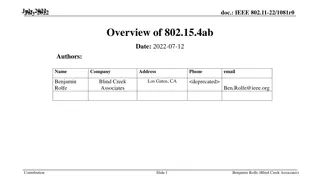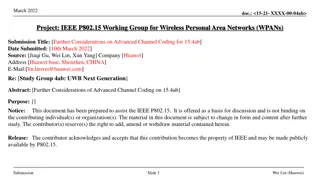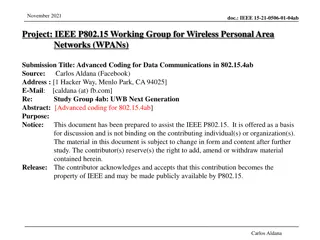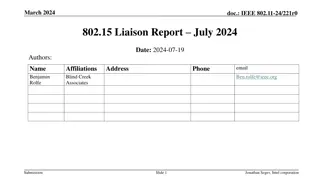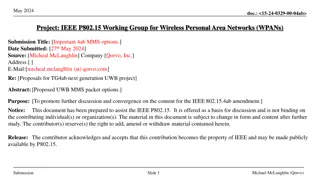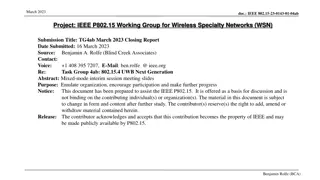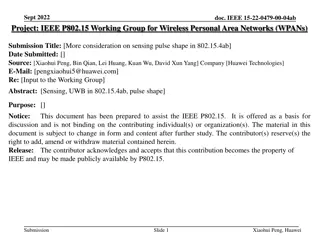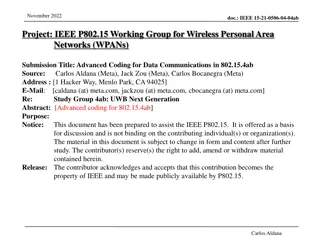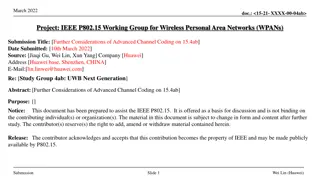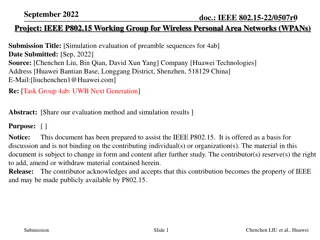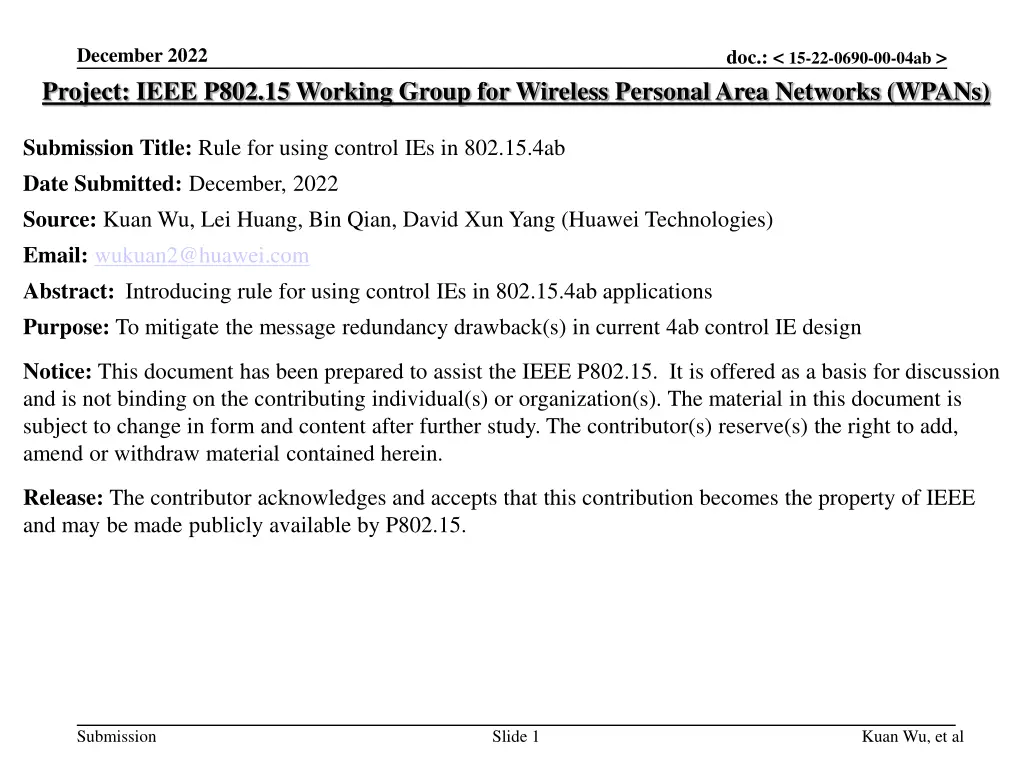
Rule for Using Control IEs in IEEE 802.15.4ab Applications
Enhance IEEE 802.15.4ab applications by introducing a new rule for using control Information Elements (IEs) to mitigate message redundancy. This document proposes solutions for interference mitigation, coexistence improvement, backward compatibility, and more, aiming to improve accuracy, reliability, and power consumption in wireless personal area networks (WPANs).
Download Presentation

Please find below an Image/Link to download the presentation.
The content on the website is provided AS IS for your information and personal use only. It may not be sold, licensed, or shared on other websites without obtaining consent from the author. If you encounter any issues during the download, it is possible that the publisher has removed the file from their server.
You are allowed to download the files provided on this website for personal or commercial use, subject to the condition that they are used lawfully. All files are the property of their respective owners.
The content on the website is provided AS IS for your information and personal use only. It may not be sold, licensed, or shared on other websites without obtaining consent from the author.
E N D
Presentation Transcript
December 2022 Project: IEEE P802.15 Working Group for Wireless Personal Area Networks (WPANs) doc.: < 15-22-0690-00-04ab > Submission Title: Rule for using control IEs in 802.15.4ab Date Submitted: December, 2022 Source: Kuan Wu, Lei Huang, Bin Qian, David Xun Yang (Huawei Technologies) Email: wukuan2@huawei.com Abstract: Introducing rule for using control IEs in 802.15.4ab applications Purpose: To mitigate the message redundancy drawback(s) in current 4ab control IE design Notice: This document has been prepared to assist the IEEE P802.15. It is offered as a basis for discussion and is not binding on the contributing individual(s) or organization(s). The material in this document is subject to change in form and content after further study. The contributor(s) reserve(s) the right to add, amend or withdraw material contained herein. Release: The contributor acknowledges and accepts that this contribution becomes the property of IEEE and may be made publicly available by P802.15. Submission Slide 1 Kuan Wu, et al
December 2022 doc.: < 15-22-0690-00-04ab > PAR Objective Proposed Solution (how addressed) Safeguards so that the high throughput data use cases will not cause significant disruption to low duty-cycle ranging use cases Interference mitigation techniques to support higher density and higher traffic use cases Other coexistence improvement Backward compatibility with enhanced ranging capable devices (ERDEVs) Improved link budget and/or reduced air-time Additional channels and operating frequencies Introducing the rule for using AC IE and ARC IE in one-to- many/many-to-many ranging scenarios Improvements to accuracy / precision / reliability and interoperability for high-integrity ranging Reduced complexity and power consumption Hybrid operation with narrowband signaling to assist UWB Enhanced native discovery and connection setup mechanisms Sensing capabilities to support presence detection and environment mapping Low-power low-latency streaming Higher data-rate streaming allowing at least 50 Mbit/s of throughput Support for peer-to-peer, peer-to-multi-peer, and station-to- infrastructure protocols Infrastructure synchronization mechanisms Submission Slide 2 Kuan Wu, et al
December 2022 doc.: < 15-22-0690-00-04ab > Previous Contributions and references 1. DCN 500r0 (September 2022) New Control IE for 4ab applications New control IE is proposed to support the configuration for multiple 4ab applications. 2. DCN 646r0 (November 2022) UWB In-band Discovery 3. IEEE Standard for Low-Rate Wireless Networks Amendment 1: Enhanced Ultra Wideband (UWB) Physical Layers (PHYs) and Associated Ranging Techniques, IEEE Standard 802.15.4z-2020 (Amendment to IEEE Standard 802.15.4-2020), IEEE SA, pp. 1 174, Aug. 25, 2020 4. DCN 585r1 (November 2022) One-to-Many Ranging using NBA-MMS Extending NBA-MMS usage to one-to-many use cases by concatenating multiple responders 5. DCN 205r0 (July 2022) Multi-millisecond Ranging Non-interlacing MMS ranging is proposed for long-range line-of-sight, and short-range highly attenuated first path 6. DCN 255r1 (May 2022) MAC considerations on unified control for UWB sensing and ranging Preliminary study on unified MAC design for UWB sensing and ranging Submission Slide 3 Kuan Wu, et al
December 2022 doc.: < 15-22-0690-00-04ab > Recap: Application Control IE design Application Control IE (AC IE) [1]-[2] is proposed to configure the control parameters for various 4ab applications, including ranging, data comm., sensing, and TDOA. For Ranging Control field, re-using some fields from the legacy 4z Advanced Ranging Control IE (ARC IE) [1]: Mutli-node Mode, Ranging Round Usage, STS Packet Config, Deferred Mode, MMRCR Bits: 0-1 2-3 4-5 6 7 8 9-15 Octets: 1 Number of Preamble Fragments Present Ranging Round Usage Number of Preamble Fragments Multi-node Mode STS Packet Config Deferred Mode MMRCR Reserved Octets: Variable Octets: TBD Bits: 0 1 2 3 4-7 Variable Variable Variable Data Comm Control Present Ranging Control Present Sensing Control Present TDoA Control Present Data Comm Control Common Control Ranging Control Sensing Control TDoA Control Reserved Submission Slide 4 Kuan Wu, et al
December 2022 doc.: < 15-22-0690-00-04ab > Recap: Application Control IE design (cont.) In a one-to-many ranging or many-to-many ranging An initiator may perform ranging exchange with multiple responders, each of which is either 4ab ERDEV(s) or 4z ERDEV(s). Response frames from multiple different responders can be scheduled for transmissions in a sequential order [3]-[4]. A Ranging Control Message (RCM) transmitted at the beginning of a ranging round may include both AC IE and ARC IE, so that all ranging responders are able to obtain necessary control information due to the following facts: 4z device is able to decode ARC IE, but is unable to decode AC IE. 4ab device is able to decode both ARC IE and AC IE. Observation & Problem: Some control information are included both in AC IE and ARC IE, especially some common ranging parameters These overlapping information may cause additional signaling overhead and increased processing complexity of 4ab ERDEVs. Motivation: In this contribution, we introduce the rule for using AC IE and ARC IE in one-to-many/many-to-many ranging scenarios Submission Slide 5 Kuan Wu, et al
December 2022 doc.: < 15-22-0690-00-04ab > Rule for using AC IE and ARC IE Introducing the Common Ranging Control Presence and Common Ranging Control fields in the Ranging Control field of AC IE. If both AC IE and ARC IE are present in the same RCM, then Common Ranging Control Present field is set to zero to indicate that the Common Ranging Control field is not present. Effect: The AC IE can carry only supplemental control information to the ARC IE for ranging procedures configuration reducing overhead and complexity for receiver(s) Bits: 0 1 2-7 Octets: 0/1 0/1 Number of Preamble Fragments Present Common Ranging Control Present Number of Preamble Fragments Common Ranging Control Reserved Bits: 0-1 2-3 4-5 6 7 Ranging Round Usage Multi-node Mode STS Packet Config Deferred Mode MMRCR Submission Slide 6 Kuan Wu, et al
December 2022 doc.: < 15-22-0690-00-04ab > Rule for using AC IE and ARC IE (cont.) In a one-to-many/many-to-many ranging, if multiple responders include both 4z devices and 4ab devices Case (a): If RCM contains ARC IE but does not contain AC IE, then only 4z ranging is performed between initiator and responder(s). (NBA)-MMS UWB procedure is disallowed in this case. Case (b): If RCM contains ARC IE and the AC IE which carries supplemental control information to the ARC IE, then 4z ranging procedure is performed between initiator and 4z responder(s), while 4ab ranging procedure is performed between initiator and 4ab responder(s). The ranging parameters for 802.15.4ab-compliant ERDEV(s) are jointly configurated by the AC IE and the ARC IE. Case (a) Case (b) Submission Slide 7 Kuan Wu, et al
December 2022 doc.: < 15-22-0690-00-04ab > Summary In this contribution, we introduce the Common Ranging Control Presence and Common Ranging Control fields in the Ranging Control field of the AC IE. The Common Ranging Control field contains Multi-node Mode, Ranging Round Usage, STS Packet Config, Deferred Mode and MMRCR fields, which are overlapping with ARC IE If both AC IE and ARC IE are present in the same RCM, then Common Ranging Control Present field is set to zero to indicate the Common Ranging Control field is not present. Submission Slide 8 Kuan Wu, et al





